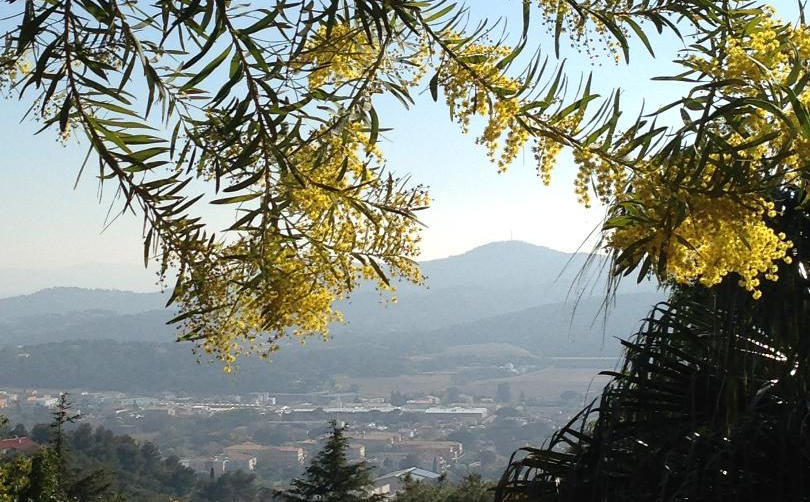
All that glitters on the French Riviera, the Côte d’Azur, is not 18K gold. As Corinne LaBalme reports, bright yellow mimosa flowers add Mother Nature’s Midas Touch to the winter season, particularly along the Mimosa Route between the medieval village of Bormes-les-Mimosas and the perfume capital of Grasse.
From December through March, while grey is the predominant color of the skies of northern Europe, the coastal roads on the Côte d’Azur in southeast France burst into a Kodachrome blur of neon-yellow flowers wedged between a brilliant blue sky and the turquoise Mediterranean.
The mimosa, a hardy Australian acacia, was first introduced to France by the explorer James Cook, who presented the seeds to the future Empress Josephine. But mimosa madness didn’t take root until the late 19th century when the northern aristocrats wintering on the Riviera brightened their holiday villas with this cheery foreign flower that stubbornly stuck to its Australian blooming schedule.
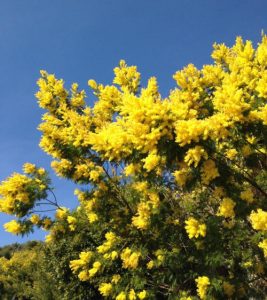
The Côte d’Azur remained a winter destination until the advent of Brigitte Bardot and the bikini turned the region into a summertime fantasy land. More recently, with the goal of reinvigorating winter tourism, several towns in the Var and Alpes-Maritimes regions have banded together to form La Route des Mimosas, the Mimosa Route, 80 miles of bright yellow horticultural heaven between the medieval village of Bormes-les-Mimosas and the perfume capital of Grasse.
The major mimosa action takes place on February weekends when the towns on the route hold their corsos, parades with drum majorettes, local marching bands, and flower-bedecked floats that are planned and painstakingly assembled by village volunteer groups.
This route through the smaller villages is worth following in the summer as well as it provides respite from the crowds in the well-known beach resorts of the Riviera. Even when the mimosa season is over, the gardens and protected nature refuges along this route are among the most exceptional botanical treasures in France even though one botanist’s treasure can be another botanist’s pest, as you’ll discover in your travels along the Mimosa Route.
Bormes-les-Mimosas

The village of Bormes – after enduring the “place-with-all-the-mimosas” epithet for years – changed its name to include the ubiquitous flowers in 1968. And it makes sense: Of the 1,200 varieties of mimosa plants that exist across the world, the latest local plant census claims that 700 different mimosa varieties reside within town limits.
Moreover, the National Conservancy of Mimosa is centered in the greenhouses at the Pépinière Cavatore which nurtures 7,000-8,000 mimosa plants every year. Horticulturist Julien Cavatore waxes eloquent on his family’s specialized knowledge of the Australian acacia. Mimosas, he explains, flourish in the Mediterranean
coastal region although the fickle plants experience difficulties just a few miles (and micro-climates) north in Aix-en-Provence.

“You can’t buy one of my ‘babies’ unless I think you can care for it properly indoors or replant it in an appropriate garden environment,” Cavatore says. Indoor mimosa seedlings must be coddled like a cranky, anti-social houseguests, sequestered in an otherwise unused, unheated room with frequent watering and careful attention to their specific soil requirements.
Therefore, it’s a whole lot easier to connect with mimosas al fresco. The Australian gardens in Bormes-les-Mimosa’s spectacular, three-quarter acre Parc Gonzalez showcase the golden flowers in addition to other exotic plants such as banksia and eucalyptus. For fans of manmade culture, note that architectural jewels such as the 16th-century chapel dedicated to Saint Francis of Assisi (who visited Bormes on his anti-plague tour in 1481) show up in many of the garden settings.
The town’s major non-floral tourist attraction is the Fort de Brégançon, a 15th century military installation designated as a presidential vacation residence since 1968. Rarely used in recent years while running up an annual maintenance bill of 200,000 €, Former President François Hollande opened it to the public in 2013 although his successor seems less likely to relinquish the keys on a permanent basis. President Emmanuel Macron has already installed a swimming pool on the premises and entertained Theresa May at Brégançon for Brexit talks in August 2018. Open to visitors in July and September only. Tickets available through the Bormes-les-Mimosas Tourist Office.
The Domaine du Rayol in Rayol-Canadel-sur-Mer
In 1908, Parisian businessman Alfred Courmes purchased 99 acres of wild beachfront terrain and began to build his personal paradise with a mini-farm, a grandiose villa and an antique-style pergola. After several subsequent private owners, the property was destined to be chopped up for building units in 1974 until several local associations protested.
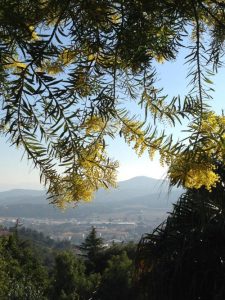
The environmentalists’ ecological dream came true in 1989 when the land was acquired by the Conservatoire du Littoral, the French coastal protection agency. The Domaine du Rayol, 49 acres of Mediterranean herb-and-pine-scented brush called maquis, is the anti-Versailles. No orderly rows of petunias. No geometric parterres. No fountains with Greek gods. The Domaine du Rayol is a “planetary garden” in the words of its landscaper-in-chief Gilles Clément, as well as a “moving garden” in constant evolution.
The first idea on Clément’s drawing board was a patchwork of regional greenery native to Mediterranean-style climates all over the world. Thus, during the December-to-March mimosa season, it’s hard to miss the bright gold Australian reserve. But there’s much else to see as well as other areas are devoted to graceful Asian ginko trees, Californian chaparral and Jurassic Park-style giant ferns from New Zealand. A remarkable 300-year-old cork tree stands as a gnarled reminder that this region once earned its baguettes-and-butter from the production of wine corks.
Nature lovers should plan for a full day to explore the grounds; there’s a charming outdoor café for lunch and snacks. And the plant life isn’t all on dry land either. Visitors can check out the seaweed too because the Domaine offers summertime wading tours along the beachfront as well as snorkeling expeditions. For the latter, all equipment is provided. Reservations are mandatory through the Domaine du Rayol website. While on that site, see if your plans coincide with one of the tree-climbing Sundays or the summer concert schedule.
Sainte Maxime and Saint Raphael
These side-by-side beach resorts have very different architectural profiles: The most lavish holiday villas in Sainte Maxime are stripped-down examples of Art Deco, whereas the shoreline of Saint-Raphael is dominated by the extravagant, wedding-cake fantasies of the Belle Epoque.
Both towns provide a large choice of Provençal boutiques. During winter, many local pastry shops stock mimosa-flavored chocolates produced at the artisanal candy workshop “La Muscadine” in Sainte-Maxime. Like Ray Bradbury’s Dandelion Wine, they taste like Riviera sunshine on the tongue. If you miss the mimosa season, console yourself with Muscadine’s chocolate creations flavored with lavender, violet, and rose petals.

Mimosa continues to delight tourists, florists and perfume companies (more later) but every splash of yellow at the Massif de l’Estérel nature reserve in Saint Raphael is regarded with fear and loathing by the Park Service. It turns out that mimosa, like most things in life, has a dark side.
The reserve, a hiker’s dream, dominated by dramatic red cliffs overlooking the Mediterranean, has become an anti-mimosa battleground. Mimosa may be notoriously picky about its climate and soil preferences but, like Goldilocks, when it gets what it wants it takes over. “It’s an invasive foreign plant that crushes the local flora. Cutting, uprooting and burning simply encourages it to spread,” explains Forest Ranger André Frey. Mimosa is Nature’s Nietzsche: what doesn’t kill it, makes it stronger.
The Estérel Reserve, a haven for native Côte d’Azur pines, thyme and sage, offers a variety of walking tours and bike, VTT and even motorcycle treks are available. Information is available through the Saint Raphael Tourist Office.
Tanneron and Mandelieu-La Napoule
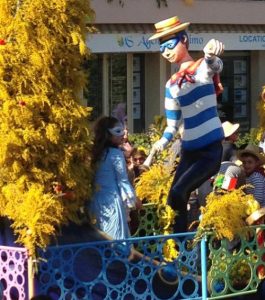
In August 1986, fires destroyed 12,480 acres of Riviera forest and the hardest-hit area was the Tanneron Mountain. During mimosa season, that hill is now entirely and breathtakingly golden in winter; the traditional Mediterranean brush is nowhere in sight, which is worrisome to many botanists. Tanneron can therefore be seen is either a glorious symbol of flower power or the scary incubator of yellow peril. It all depends on what side of the botanical barricades you’re on.
Just a few miles away, Mandelieu-La Napoule takes most of its golden color from the Palme d’Or (The Gold Palm) at the nearby Film Festival. A bedroom community of Cannes, Mandelieu is more international than the previous towns on the route and has its own Michelin-starred restaurant, L’Oasis.
Nevertheless, it hosts its own folkloric corso (the 2019 theme was Marco Polo complete with dromedaries) which parades right past the 14th century chateau lovingly restored by American artist Henry Clews Jr (1876 – 1937) and now open to the public. There’s a distinct fairy-tale aura to the castle—the stone inscription over the door reads “Once Upon a Time.”
Grasse
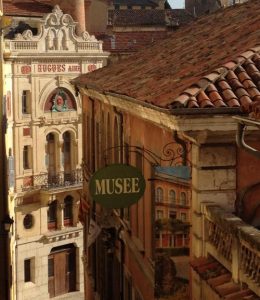
Surrounded by fields of blossoms, Grasse is the fragrance capital where mimosa (and roses and jasmine and violets…) are distilled into tiny bottles of money. Last year, it gained listing to the UNESCO Intangible Cultural Heritage register for its floral savoir-faire in the arts of perfumery.
Mimosa is one of principal scent factors in Amarige (Givenchy), Paris (Yves Saint Laurent), Champs-Elysées (Guerlain), L’Eau d’Azur (Occitane), Masumi (François Coty) and Moment Suprême (Jean Patou).
Fragonard, established in Grasse in 1926, simply calls their mimosa scent Mimosa. At present, the Perfume Museum in Grasse offers limited exhibits while under renovation. All the more reason to head to Fragonard, which has its own museum (yes, there’s a relation to the painter) and workshops (reserve ahead) where visitors can get a chance to make their own fragrance.
Planning Your Trip
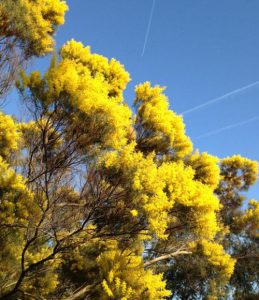
If beginning the Mimosa Route in Bormes-les-Mimosas, Toulon-Hyères is the closest airport and Toulon and Hyères are the closest TGV stations. If starting in Grasse, Nice is the more convenient choice whether arriving by train or plane.
Information on planning a trip to the areas covered by the Mimosa Road is found on the official tourist sites of the department of Var, the Côte d’Azur and the Mimosa Route, in addition to those of the towns mentioned in this article.
Fancy four-star options are thin on the ground at present but they’re in the works: The Belle Epoque-style Grand Hotel of Bormes-les-Mimosas (ca 1903), is currently under renovation and construction is slated to begin on an all-new luxury hotel on a hillside overlooking the old town of Grasse.
In the meantime, profit from charming (and bargain-priced for the Riviera) options such as the Café du Progrès in Bormes-les-Mimosas whose casual restaurant serves some of the best home-made tapenade on the coast as well as lush plats du jour such as minced lamb pastilla. The cozy inn above the restaurant has a small but refreshing pool.
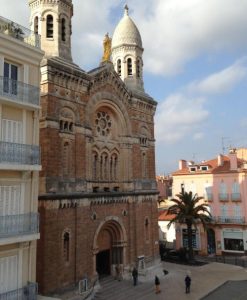
One pays extra for the waterfront views at the venerable Excelsior Hotel in Saint Raphael, but more dramatic scenery is offered by city-side rooms that overlook the remarkable Roman-Byzantine Notre-Dame de la Victoire Basilica, built in 1883 from the region’s pink sandstone.
The Café de France in Sainte-Maxime has been run by the same family since 1852. Directly across from the town’s small but lively fish market, it’s a great place to sample daurade (sea bream) in butter sauce with a side of black rice topped with white truffles. There’s live jazz on winter weekends.
© 2019, Corinne LaBalme

